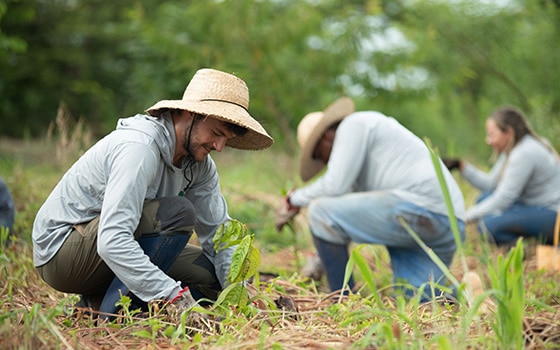The prolonged rainy season has given us more time to restore Permanent Preservation Areas and Legal Reserves. As much as we depend on the science of restoration and our knowledgeable team, we also depend on rains, something we cannot influence, but can be lucky with too!
Our ever-hard-working team has been doing their best to make the most out of the extended planting season.
Would you like to find out more about why we’ve had so much rain in the Araguaia Biodiversity Corridor? Then keep reading!

What is La Niña, how does it affect Brazil, and what does that mean for the Black Jaguar Foundation?
La Ninã and El Niño are two opposing climate patterns that can influence the weather.
Both have to do with so called “trade winds”, which refer to the movement of hot, humid air, to areas with low atmospheric pressure. When El Nino happens, the Pacific Ocean’s superficial layer of hot water moves in the direction of South America. The warm winds incite evaporation, and clouds are formed. In Brazil, this may incite more rain in Southern regions, and less in the North and Northeast.
La Niña causes the opposite to happen, cooling down the superficial waters of the Pacific Ocean. In this case, it may lead to increased rain in the Amazon Rainforest and the Northeast of Brazil.
Rainfall helps the Black Jaguar Foundation realize our mission because it gives us a wider planting window!
References
BBC. (2021, October 19). O fenômeno la niña está de volta: O que isso significa para o clima do brasil e da região. BBC News Brasil. Retrieved April 10, 2022, from https://www.bbc.com/portuguese/geral-58966796
Instituto Nacional de Pesquisas Espaciais. (n.d.). Estação Chuvosa. Clima Estao chuvosa – CPTEC/INPE. Retrieved April 10, 2022, from http://clima1.cptec.inpe.br/estacaochuvosa/pt
United Nations Office for the Coordination of Humanitarian Affairs. (2018, May 14). El Niño and La Niña. OCHA. Retrieved April 10, 2022, from https://www.unocha.org/themes/el-ni%C3%B1o/el-ni%C3%B1o-and-la-ni%C3%B1a




